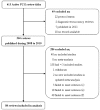A comparison of statistical methods for identifying out-of-date systematic reviews
- PMID: 23185281
- PMCID: PMC3502410
- DOI: 10.1371/journal.pone.0048894
A comparison of statistical methods for identifying out-of-date systematic reviews
Abstract
Background: Systematic reviews (SRs) can provide accurate and reliable evidence, typically about the effectiveness of health interventions. Evidence is dynamic, and if SRs are out-of-date this information may not be useful; it may even be harmful. This study aimed to compare five statistical methods to identify out-of-date SRs.
Methods: A retrospective cohort of SRs registered in the Cochrane Pregnancy and Childbirth Group (CPCG), published between 2008 and 2010, were considered for inclusion. For each eligible CPCG review, data were extracted and "3-years previous" meta-analyses were assessed for the need to update, given the data from the most recent 3 years. Each of the five statistical methods was used, with random effects analyses throughout the study.
Results: Eighty reviews were included in this study; most were in the area of induction of labour. The numbers of reviews identified as being out-of-date using the Ottawa, recursive cumulative meta-analysis (CMA), and Barrowman methods were 34, 7, and 7 respectively. No reviews were identified as being out-of-date using the simulation-based power method, or the CMA for sufficiency and stability method. The overall agreement among the three discriminating statistical methods was slight (Kappa = 0.14; 95% CI 0.05 to 0.23). The recursive cumulative meta-analysis, Ottawa, and Barrowman methods were practical according to the study criteria.
Conclusion: Our study shows that three practical statistical methods could be applied to examine the need to update SRs.
Conflict of interest statement
Figures
Similar articles
-
The future of Cochrane Neonatal.Early Hum Dev. 2020 Nov;150:105191. doi: 10.1016/j.earlhumdev.2020.105191. Epub 2020 Sep 12. Early Hum Dev. 2020. PMID: 33036834
-
A descriptive analysis of child-relevant systematic reviews in the Cochrane Database of Systematic Reviews.BMC Pediatr. 2010 May 20;10:34. doi: 10.1186/1471-2431-10-34. BMC Pediatr. 2010. PMID: 20487565 Free PMC article.
-
An encouraging assessment of methods to inform priorities for updating systematic reviews.J Clin Epidemiol. 2009 Mar;62(3):241-51. doi: 10.1016/j.jclinepi.2008.04.005. Epub 2008 Sep 10. J Clin Epidemiol. 2009. PMID: 18783919
-
Statistical methods can be improved within Cochrane pregnancy and childbirth reviews.J Clin Epidemiol. 2011 Jun;64(6):608-18. doi: 10.1016/j.jclinepi.2010.08.002. Epub 2010 Dec 13. J Clin Epidemiol. 2011. PMID: 21109399 Review.
-
Assessment of publication bias required improvement in oral health systematic reviews.J Clin Epidemiol. 2016 Aug;76:118-24. doi: 10.1016/j.jclinepi.2016.02.019. Epub 2016 Mar 3. J Clin Epidemiol. 2016. PMID: 26939926 Review.
Cited by
-
Citation Discovery Tools for Conducting Adaptive Meta-analyses to Update Systematic Reviews.J Prev Med Public Health. 2016 Mar;49(2):129-33. doi: 10.3961/jpmph.15.074. Epub 2016 Mar 14. J Prev Med Public Health. 2016. PMID: 27055549 Free PMC article.
-
Descriptive analysis of cochrane child-relevant systematic reviews: an update and comparison between 2009 and 2013.BMC Pediatr. 2017 Jul 11;17(1):155. doi: 10.1186/s12887-017-0908-7. BMC Pediatr. 2017. PMID: 28693463 Free PMC article.
-
Developing and applying a 'living guidelines' approach to WHO recommendations on maternal and perinatal health.BMJ Glob Health. 2019 Aug 19;4(4):e001683. doi: 10.1136/bmjgh-2019-001683. eCollection 2019. BMJ Glob Health. 2019. PMID: 31478014 Free PMC article. Review.
-
When and how to update systematic reviews: consensus and checklist.BMJ. 2016 Jul 20;354:i3507. doi: 10.1136/bmj.i3507. BMJ. 2016. PMID: 27443385 Free PMC article.
-
Effects of exercise in the treatment of overweight and obese children and adolescents: a systematic review of meta-analyses.J Obes. 2013;2013:783103. doi: 10.1155/2013/783103. Epub 2013 Dec 24. J Obes. 2013. PMID: 24455215 Free PMC article.
References
-
- Cook D, Mulrow C, Haynes R (1997) Systematic reviews: Synthesis of best evidence for clinical decisions. Ann Intern Med 126: 376–380. - PubMed
-
- Jadad A, Cook D, Jones A, Klassen T, Tugwell P, et al. (1998) Methodology and reports of systematic reviews and meta-analyses: a comparison of Cochrane reviews with articles published in paper-based journals. JAMA 280: 278–280. - PubMed
Publication types
MeSH terms
LinkOut - more resources
Full Text Sources
Medical


